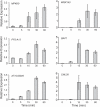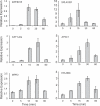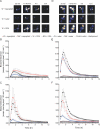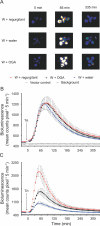Mechanical stress induces biotic and abiotic stress responses via a novel cis-element
- PMID: 17953483
- PMCID: PMC2039767
- DOI: 10.1371/journal.pgen.0030172
Mechanical stress induces biotic and abiotic stress responses via a novel cis-element
Abstract
Plants are continuously exposed to a myriad of abiotic and biotic stresses. However, the molecular mechanisms by which these stress signals are perceived and transduced are poorly understood. To begin to identify primary stress signal transduction components, we have focused on genes that respond rapidly (within 5 min) to stress signals. Because it has been hypothesized that detection of physical stress is a mechanism common to mounting a response against a broad range of environmental stresses, we have utilized mechanical wounding as the stress stimulus and performed whole genome microarray analysis of Arabidopsis thaliana leaf tissue. This led to the identification of a number of rapid wound responsive (RWR) genes. Comparison of RWR genes with published abiotic and biotic stress microarray datasets demonstrates a large overlap across a wide range of environmental stresses. Interestingly, RWR genes also exhibit a striking level and pattern of circadian regulation, with induced and repressed genes displaying antiphasic rhythms. Using bioinformatic analysis, we identified a novel motif overrepresented in the promoters of RWR genes, herein designated as the Rapid Stress Response Element (RSRE). We demonstrate in transgenic plants that multimerized RSREs are sufficient to confer a rapid response to both biotic and abiotic stresses in vivo, thereby establishing the functional involvement of this motif in primary transcriptional stress responses. Collectively, our data provide evidence for a novel cis-element that is distributed across the promoters of an array of diverse stress-responsive genes, poised to respond immediately and coordinately to stress signals. This structure suggests that plants may have a transcriptional network resembling the general stress signaling pathway in yeast and that the RSRE element may provide the key to this coordinate regulation.
Conflict of interest statement
Competing interests. The authors have declared that no competing interests exist.
Figures










References
-
- Fujita M, Fujita Y, Noutoshi Y, Takahashi F, Narusaka Y, et al. Crosstalk between abiotic and biotic stress responses: a current view from the points of convergence in the stress signaling networks. Curr Opin Plant Biol. 2006;9:436–442. - PubMed
-
- Bostock RM. Signal crosstalk and induced resistance: straddling the line between cost and benefit. Annu Rev Phytopathol. 2005;43:545–580. - PubMed
-
- Vorwerk S, Somerville S, Somerville C. The role of plant cell wall polysaccharide composition in disease resistance. Trends Plant Sci. 2004;9:203–209. - PubMed
Publication types
MeSH terms
Substances
Grants and funding
LinkOut - more resources
Full Text Sources
Molecular Biology Databases

